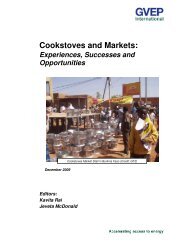Household Dynamics - HEDON Household Energy Network
Household Dynamics - HEDON Household Energy Network
Household Dynamics - HEDON Household Energy Network
You also want an ePaper? Increase the reach of your titles
YUMPU automatically turns print PDFs into web optimized ePapers that Google loves.
GENERAL<br />
Figure 2: several layers of the<br />
reflective insulation are shown here.<br />
From top to bottom: Aluminium foil<br />
with Pe backing, 5-7mm fluffy wool,<br />
shining metalized foil, 5-7mm fluffy<br />
wool, and another shining metalized<br />
food packing foil<br />
Figure 3: The pressure cooker inside<br />
the heat storage box is covered<br />
with broken pieces of ePs insulation<br />
material and two layers of insulating<br />
bubble foil<br />
This foil is commonly used for pipe<br />
insulation, under laminate floors, for house<br />
insulation and is becoming widely available.<br />
Heat-retention cookers are commonly<br />
made from insulation materials such<br />
as Expanded Polystyrene (EPS €=0.04<br />
W/m.K), loose wool (€=0.05 W/m.K), straw<br />
(€=0.08 W/m.K) or even less insulating<br />
materials. However, the highly reflective<br />
metalized foils are far more effective and<br />
require less space.<br />
For a total heat resistance of R=<br />
3.0 m.K/W, a material thickness of 12cm<br />
EPS is needed or 24cm loose straw, making<br />
it a voluminous box. Each reflective foil<br />
with 3mm PE backing has an R value of<br />
about 0.8 m.K/W. Hence, only four foils<br />
are needed to reach R=3.2 m.K/W, being<br />
only 2cm in thickness.<br />
5. After placing the pressure cooker in the<br />
heat-retention box, it was covered with<br />
small broken pieces of EPS packing<br />
material, followed by a layer of bubble<br />
foil. By this time (25 minutes), the<br />
traditional cooking pot had started to<br />
boil and the gas flame under this pot<br />
was lowered slightly to simmering.<br />
6. After two hours, during which<br />
two cups of water had been added<br />
(evaporation), the traditional dish was<br />
ready. The pressure cooker was taken<br />
out of the heat-retention box. The<br />
pressure cooker had retained some of<br />
its pressure, meaning it had actually<br />
continued to cook the ingredients at a<br />
30<br />
higher temperature than the traditional<br />
cooking pot.<br />
7. Comparing the two soups, all the<br />
Welthungerhilfe project staff agreed that<br />
the soup cooked in the pressure cooker<br />
tasted better and the carrots were softer.<br />
One female staff member commented:<br />
“Now I do not need to be home two<br />
hours before lunch in order to start<br />
cooking, I can make the soup in the<br />
morning and it is still warm at lunch.”<br />
8. The pressure cooker used only 17<br />
minutes of gas while the traditional pot<br />
took 25 minutes (high flame to come to<br />
the boil) and 120 minutes (simmering<br />
time); in total 145 minutes. This meant<br />
that the pressure cooker used only<br />
12% of the gas (or other cooking fuel<br />
such as firewood) as compared to the<br />
traditional cooking method.<br />
The exercise demonstrated that the<br />
combination of the pressure cooker and<br />
heat-retention box results in considerable<br />
savings of cooking fuel (actually oneeighth<br />
of the amount). The high saving<br />
is partly due to the inefficient cooking<br />
method of the traditional dish requiring<br />
long cooking times. This correlates<br />
with houses being poorly insulated and<br />
requiring constant heating during the<br />
winter. The exercise was concluded with<br />
another two short training sessions on (a)<br />
the technology of the pressure cooker and<br />
its use, and (b) the technical design of the<br />
heat retention box.<br />
The Welthungerhilfe programme<br />
uses the Afghan model pressure cooker<br />
now because it is available in the capital<br />
Dushanbe and it can be used on any kind<br />
of stove (gas, electricity, open fire and<br />
solar cooker).<br />
Safety requirements<br />
Using the pressure cooker without<br />
knowing how it works can lead to<br />
dangerous situations, especially when the<br />
fire under the pot cannot be accurately<br />
tempered. With vigorous boiling, steam<br />
and foam will develop inside the pressure<br />
cooker. When the pressure pot is filled<br />
to the rim, the foam and bubbling food<br />
will clog the pressure control steam vent.<br />
This will excessively raise the pressure and<br />
temperature, and without a proper safety<br />
valve, the pot may explode.<br />
– A pressure cooker works on steam<br />
development, therefore water is an<br />
essential ingredient<br />
– Pressure cookers having an increased<br />
height top lid are slightly safer than<br />
pressure cookers with a flat top, because<br />
foam less easily blocks the steam vent<br />
– A pressure cooker should not be used<br />
for frying<br />
– Aluminium cooking pots should not<br />
be cleaned on the inside with soda or a<br />
metallic sponge; otherwise, aluminium<br />
will enter into the food, having a<br />
negative health aspect (Alzheimer’s)<br />
Pressure cookers are on the market in<br />
different price classes and qualities. In<br />
Afghanistan (4 litre, USD 25), low cost<br />
aluminium pressure cookers are available,<br />
and these are now being introduced by<br />
Welthungerhilfe as a result of the training<br />
exercise. Considering the amount of gas<br />
saved through a pressure cooker, the cost<br />
of the cooker is recuperated within a<br />
summer season.<br />
Figure 4: The two pots are filled<br />
with exactly the same amount of<br />
ingredients. The pressure cooker has<br />
less water because evaporation will<br />
be far less





